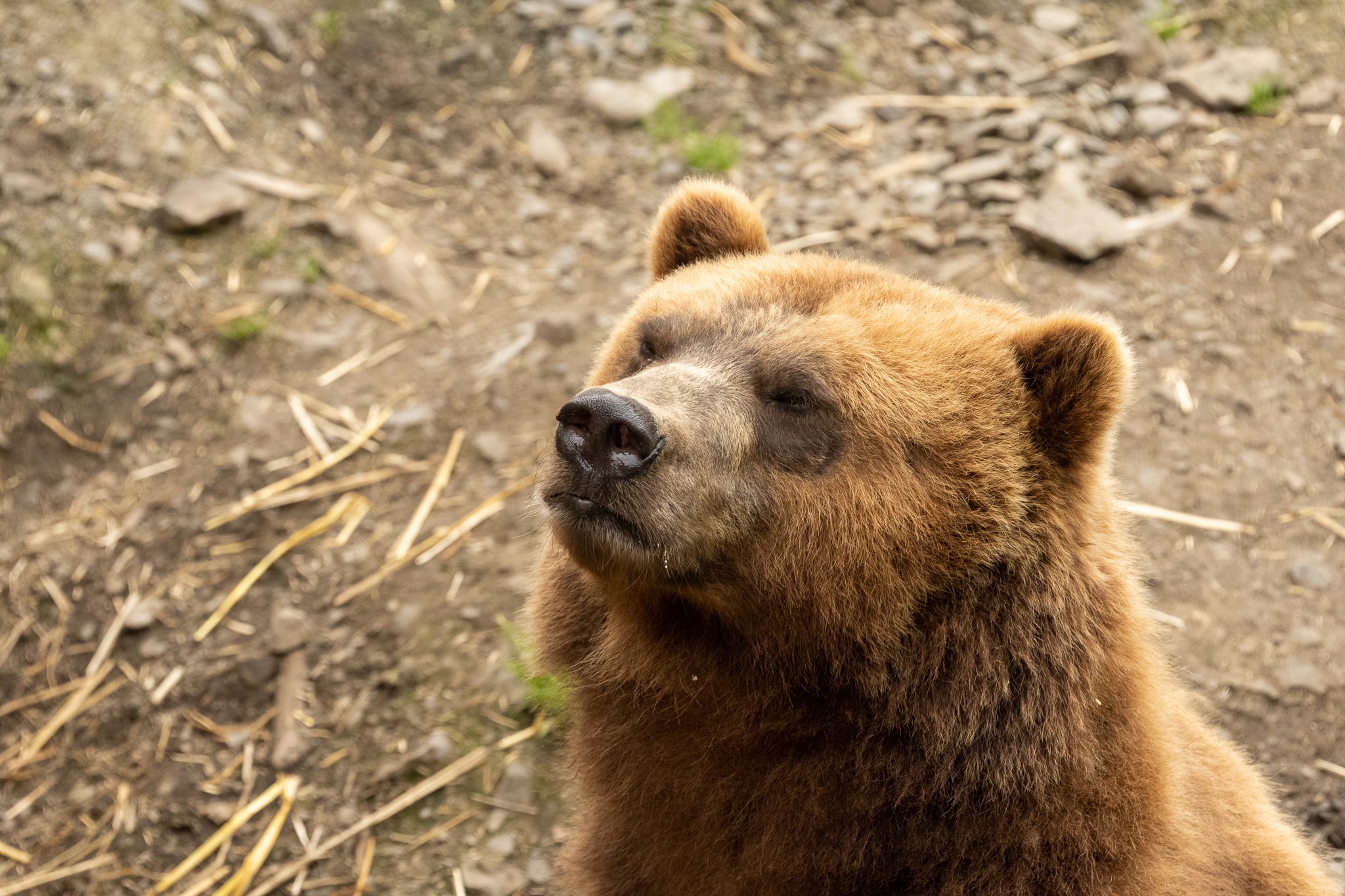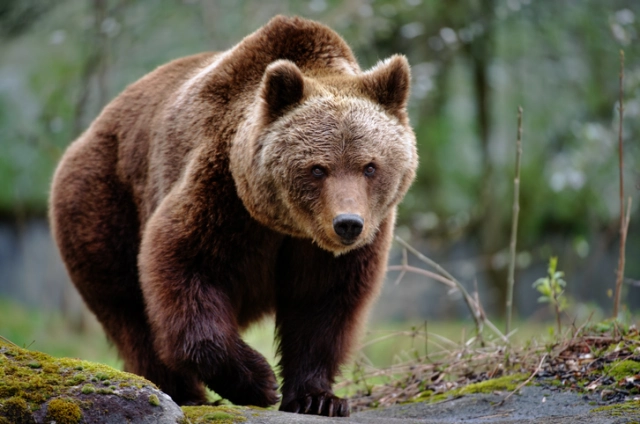Bears have always held a particular fascination, and a certain amount of fear, for me. When my husband and I found ourselves in Sitka, Alaska, for a few days last month, after cruising around the Inland Passage in a catamaran for a week, we heard about The Fortress of the Bear, a refuge for orphaned bears, and we knew we had to visit.
A little outside of town, the sanctuary backs up to the Tongass National Forest. So, while the bears are contained, they live in an open-aired environment and regularly get to see Bald Eagles cruising just overhead.
There is no bear rehabilitation program in Alaska, so these bears will live out their lives at the Fortress. But they are lucky bears because if they had not been rescued, they would not have survived in the wild.

They have their own section of the sanctuary, which backs right up to a hillside thick with trees. And, while they are contained from escaping by high-sided walls, they live in a completely open-air environment. We saw three Bald Eagles soaring right overhead while we were there.

Smokey and her two siblings were orphaned in Seward, in October 2013, when their mother was shot and killed. Smokey had hidden herself in a small shack at the Spring Creek Correctional Center and had nothing to eat except candy wrappers and cigarette butts. She was starving and terrified. The authorities were called in, and Smokey was trapped and sent to an animal shelter.
Orphaned cubs like Smokey are typically euthanized. But Smokey had a better fate. Her story ended up on the news, in local papers and even on Facebook, where it was picked up by the Angels for Animals Network and eventually went viral.
Thousands of people around the world spread the word, starting a campaign for Smokey to be re-homed rather than destroyed.
The Fortress of the Bear agreed to take her, but they thought that she would be lonely as the sole black bear resident, so they decided to also adopt Bandit, a male black bear from Juneau as well. And then, six weeks later, Smokey’s biological sister, Tuliaan, was also found and sent to the Fortress.
When we arrived, Tuli (Smokey’s biological sister) and Bandit looked like they were just “hanging out” and gossiping about the day. Can you see Bandit’s little white heart on his chest?

Bandit arrived four days after Smokey, on October 28th 2013. But, unlike Smokey, who was exposed to quite a bit of human contact and attention when she was first trapped, Bandit was tranquilized while hiding in a crab apple tree and was then sent by plane to Sitka. He was confused, wild and grouchy when he first arrived at the facility, but the bear keepers spent long hours working closely with him to build up his his confidence around people.
He earned his name because of his reputation for stealing any food bowls or other items he could get his paws on. Once he relaxed and became more accustomed to his new home, he even learned to take food from people’s hands.

Chaik, a brown bear, holds the record for being at the sanctuary the longest. He was rescued in 2007 after his mother was killed while breaking into the kitchen at a fishing lodge and surprising the chef. The staff at the lodge began putting out food for the cubs to keep them from starving. Eventually, both Chaik and his brother were captured and brought to the Fortress of the Bear.

We just loved the way he sits like a yogi in paschimottanasana (forward fold).
Chaik and his sister, Toby, really seemed to have a tight bond and were quite curious about the visitors.

Toby, the lone female brown bear has taken on the role of “mothering” Chaik and Lucky. She and her brothers found us when they were 1½ years old after their mother died from ingesting plastic bags found in a garbage can.
Of all of the bears at the Fortress, the keepers say that Toby is the one who most likes to eat. She is the first one to the gate, when food is being prepared and she was the first bear to pick up the concept of signing for more food, by putting her paws together in front of her chest.
Her keepers noticed that, from a very early age, Toby always played with her hands, so the trainers capitalized on her movements until they had successfully trained her to make the ‘more’ sign. With her large appetite, Toby is quite persistent in signing for ‘more’ to her keepers!


The next bear is Lucky. When he was rescued, he had an injured rear paw and a severe limp. His rescuers aren’t sure what caused his injuries — perhaps he had a fight with a big bear, or he may have been hit by a car. But they did not think that he would have survived on his own.

When Lucky first arrived at the Fortress to stay after his mother had been found dead from eating too much plastic trash, he didn’t interact much. He kept back, knowing that, because of his injuries, he would be the last to get food or get the toy he wanted.
But, after physiotherapy training with his keepers, that has all changed and he is strong with no visible signs of his injured back paw. He has won the hearts of all the keepers, especially with his pouty bottom lip!
In the next photo, you can see Nuka and Nikiski, the “Seward Sisters,” who arrived at the Fortress of the Bear on August 25th 2018, when they were 8 months old. Originally from Seward, the sisters were orphaned when their mother was shot and killed for breaking in to someone’s chicken coop, trying to provide food for her cubs.
These two bears were the first ones we saw when we arrived at the Fortress of the Bear. Nuka was making quite a racket, banging on the heavy metal door which separates these two girls from the older brown bears.
The day before, the two girls had been allowed into the other bears’ enclosure while the adults were napping in their indoor area. The idea was to expose the bears to each others’ scents and start getting them used to each other so that they can, eventually, interact.
For now, Nuka and Nikiski are too small to safely be around Toby, Lucky and Chaik. But, in the spring, they will all be introduced.

Nuka is the bolder of the two cubs, quicker to check out new toys and make trouble! Nikiski is more cautious, but is gaining more confidence every day.

We thoroughly enjoyed our visit to the Fortress of the Bear. It was amazing to be able to see these creatures so up and close. While, their lives are not the same as if they were living in the wild, they have nice lives here. Their enclosures are huge, much larger than zoo enclosures, and they live under an open sky with eagles crying in the wind right over their heads.
They have developed wonderful relationships with their caretakers too. It is evident that they are loved.
Like so many other places, during the pandemic, The Fortress of the Bear has not had as many visitors, and revenue (which is used to care for the bears) is down. I feel that we, as a society, need to remember places like this, which need our help, now.
Sometimes, I close my eyes and I can still see Toby, Chaik, Lucky, Nuka and Nikiski, and Smokey, Bandit and Tuli happily frolicking in their water ponds and lounging in the sun.
I did catch glimpses of a few wild bears while we in Alaska. But these eight rescued babies really captured my heart.


